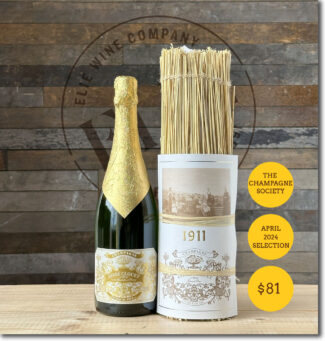The Champagne Society April 2024 Selection : Champagne André Clouet
Champagne Haute Couture
Jean-François Clouet, An Outstanding Practitioner of Pinotism, Stitches Together Bouzy’s Finest Parcels into Grand Expressions
Champagne André Clouet ‘Cuvée 1911’, Grand Cru Bouzy Brut ($81)
OR
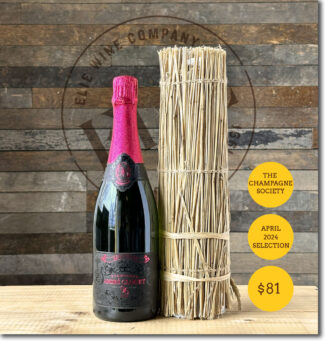
Champagne Andre Clouet ‘Spiritum 96’, Grand Cru Bouzy Rosé Brut ($81)
In any assemblage, individual grape varieties will find their niche; each performs according to its purpose and potential, whether it is power, perfume or polish. In Champagne, the Big Three—Chardonnay, Pinot Noir and Meunier—jockey for position in the hearts of Chefs de Cave, and although quality depends on location, the ability to eke out or find these locations is an indispensable tool in the belt of vignerons and the pinnacle of Champagne as an artform.
Jean-François Clouet, who was not only born and raised in Bouzy, but still lives in the 18th century village house built by his ancestors, is an example of this ideology at its finest. He says, “The vineyards are like beautiful fabrics, each one contributing textures and colors that once assembled, are transformed into a designer gown. Successfully pieced together, it is Haute Couture.”
The following wine selection represents Clouet’s slice of Champagne, a cellar where Pinot Noir rules but does not monopolize; it is terroir with the standing and privilege of its winemaker, and when it comes to Pinot-based Champagnes, an Eden for expression.
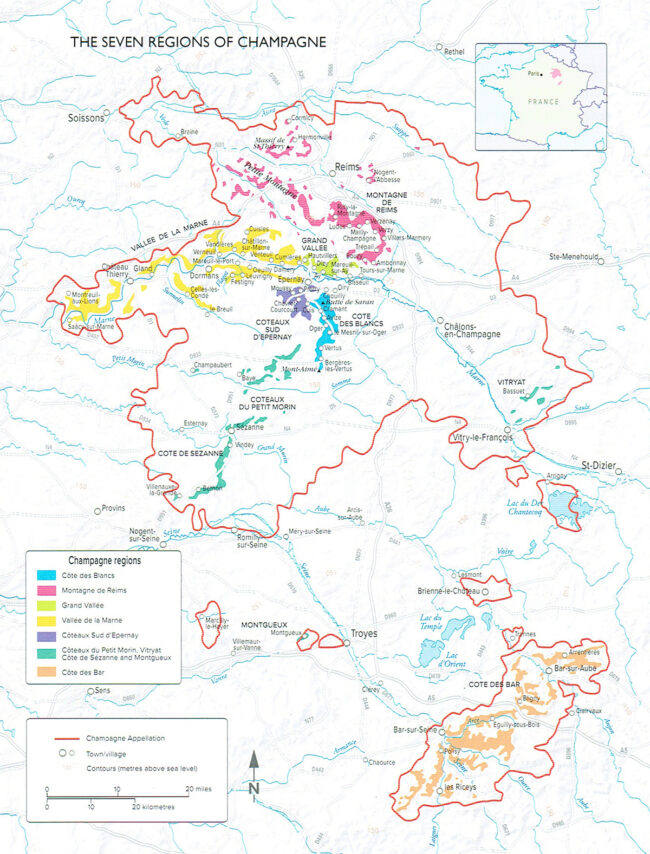
The Montagne de Reims: Pinot Noir Country
Located between Reims and Épernay, the Montagne de Reims is a relatively low-lying (under a thousand feet in elevation) plateau, mostly draped in thick forest. Vines find a suitable home on the flanks, forming a horseshoe that opens to the west.
So varied are the soils, topography and microclimates here that it is not possible to speak of the region in any unified sense. Grande Montagne de Reims, which contains all of the region’s Grand Cru vineyards, covers the northern, eastern and southern slopes of the viticultural area, and Pinot Noir plantings dominate at 57%, followed by Chardonnay (30%) and Meunier (13%). Its vineyards face a multitude of directions, and soil type varies by village, giving rise to a breadth of Pinot Noir expressions, as well as exceptional Chardonnay.
To the west, the Grande Montagne de Reims gives way to the Petite, whose bedrock is chalk, but softer than the chalk found further south on the Côte des Blancs. This sort, called ‘tuffeau’, is an extremely porous, sand-rich, calcium carbonate rock similar to what is found in wine regions of the middle Loire Valley.
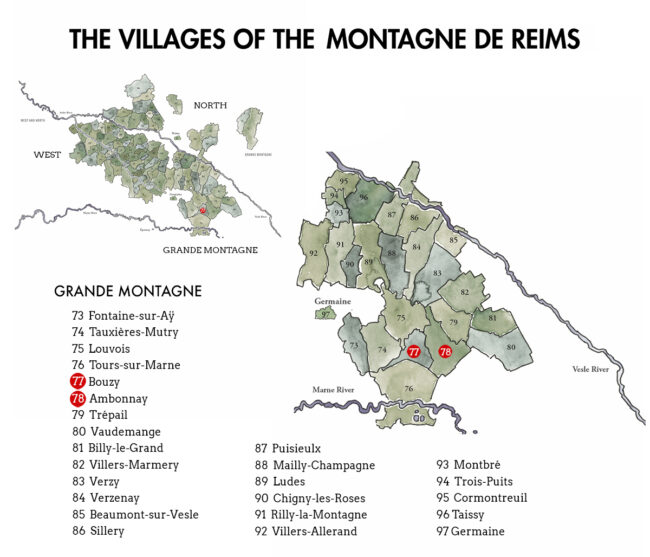
Grand Cru Bouzy: The Epicenter Of Pinot Noir
A village known for its alcohol production named Bouzy? Almost as perfect as its situation on the south-facing side of the Grande Montagne de Reims. This exposure is ideal for ripening Pinot Noir, as its sister village Ambonnay—less than half a mile away—can also attest. Chalky soils provide stimulating freshness as well as housing the deep, cool cellars essential to aging Champagne.
Bouzy has more vineyard acres than citizens (924 to 850) and 87% of the former are Pinot Noir. On the now-defunct ‘échelles des crus’, Bouzy was rated 100%, which make it a Grand Cru village. In recent years, more emphasis has been placed on individual named-sites, either vineyards or portions of vineyards; each lieu-dit is said to possess its own personality which may be exhibited as such, or blended with the others to highlight specific qualities.
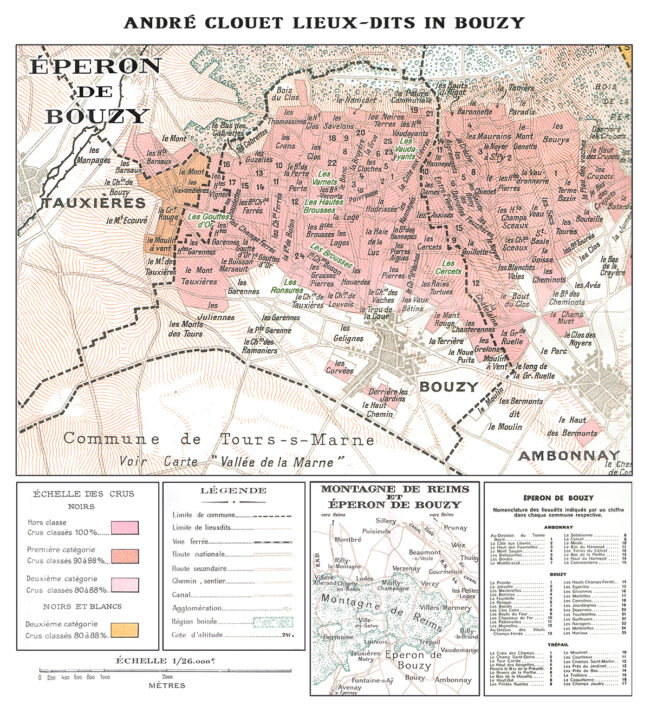
The Rare And Demanding Blancs de Noirs
All Champagne is food wine, but not many are ‘gastronomical.’ Meaning, of course, that the ethereal qualities of effervescence, along with high levels of acidity and a small amount of sugar, complement elements in almost any food, from simple poached salmon to red-hot Thai. But few Champagnes are powerful enough in aroma and palate potency to assert themselves as equals in complexity to gourmet dishes.
Many Champagnes are simply about the bubbles; in Blanc de Noir, we see the true emergence of Champagnes that are about great wines that happen to have bubbles.
Blanc de Noirs is made from Pinot Noir, Meunier, or both. The former brings bouquet and body; the latter, supple fruit and roundness. Both grapes, of course, have white flesh and are generally used to make white wine. With Blanc de Noir, a period of maceration on the skins allows the juice to soak up color, and with it, some of the character we associate with Burgundian Pinot Noir—especially, the ability to mirror qualities found in the particular soil in which it grows.
Upon release, a well-made Blanc de Noir is characterized by mouthfeel—a rich and structured texture—but perhaps even more so, powerful aromatics reminiscent of stone fruits, spices, honey, mocha, smoked wood and even a touch of leather. With vintage Blanc de Noir, allowed cellar time, tertiary notes emerge—coffee, cocoa, dried cherry and more mature yeast flavors of brioche and toast.
Champagne André Clouet
Haute Couture Viticulture
In the imagination of most casual drinkers, Champagne is typified by the Grandes Marques, and especially, the Cuvée Prestige bottles. 24 names have enjoyed a marketing monopoly for many decades; brand loyalty, as in all commodities, is built on reputation and unyielding allegiance.
Somewhat less prominent are Champagne’s grower-producers; farmers who make wine. And compared to the Les Grandes Marques (Billecart-Salmon, Bollinger, Krug, et al), Champagne André Clouet has been around longer.
The Clouet family traces its Bouzy roots to 1492 and at one time was the official printmakers for the court of King Louis XV; the classically pretty labels that grace their Champagne bottles today pay homage to their aesthetic history. Clouet grapes are sourced exclusively from 20 acres of coveted mid-slope vineyards in the Grand Cru villages of Bouzy and Ambonnay.
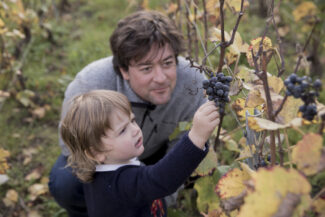
Jean-François Clouet
Born and raised in Bouzy, Jean-François Clouet still lives in his family’s 18th century home; with inimitable wit, he refers to himself as ‘a combination of winemaker and circus ringmaster.’ In fact, the French refer to him as ‘Chef de Cave’—the cellar master. He is arguably the region’s most qualified historian and insists that, without acknowledging the role that the past has played on his winemaking decisions, you can’t truly appreciate his wines.
“To understand Champagne as a whole you need to understand its political history,” he says. “Attila the Hun, the Crusaders, the Templars and Marie Antoinette have all walked here; the birth of the monarchy and the Battle of the Cathalunian Fields took place nearby. In 1911, my great grandfather designed the label that graces our bottles today; I like the idea of the work of human hands in pruning, performing the same actions as my grandfather and even the Romans, who planted vines here 2000 years ago.”
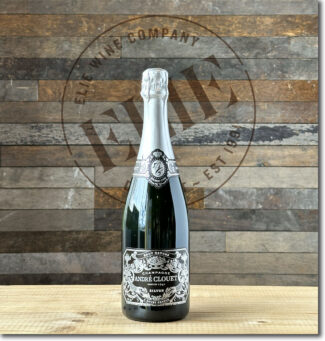 Champagne André Clouet ‘Silver’, Grand Cru Bouzy Brut Nature ($51)
Champagne André Clouet ‘Silver’, Grand Cru Bouzy Brut Nature ($51)
Clouet’s ‘Silver Label’ Champagne is made entirely with Pinot Noir from the Grand Cru village of Bouzy, mostly from the 2010 vintage (so that it has a lot of age and complexity to it already). While this cuvée has no dosage, it was aged in a former Sauternes barrel and bottle-aged for longer than the standard, resulting in additional richness. The wine displays notes of brioche and cream with buttered pastry, citrus, and a lightly oxidized apple note.
*click photo for more info
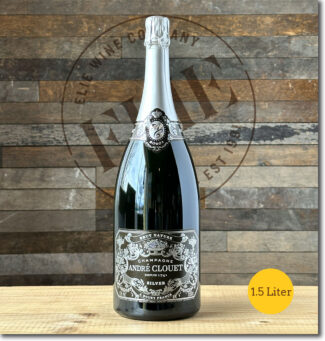 Champagne André Clouet ‘Silver’, Grand Cru Bouzy Brut Nature ($99) 1.5 Liter
Champagne André Clouet ‘Silver’, Grand Cru Bouzy Brut Nature ($99) 1.5 Liter
A little bit of sugar is unnecessary to help this medicine go down, but a smaller ratio of cork to vino is definitely beneficial. The magnum version of the Silver Label.
*click photo for more info
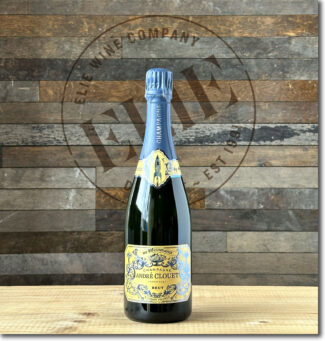 Champagne André Clouet ‘The V6 Experience’, Grand Cru Bouzy Brut ($58)
Champagne André Clouet ‘The V6 Experience’, Grand Cru Bouzy Brut ($58)
According to Jean-François Clouet, “Pinot Noir does not mature directly, in linear fashion. Upon reaching its sixth year, it passes into a phase known as ‘The Whirlwind.’ Propelled by an unseen force it reaches outward, taking on another dimension. The wine becomes charged with energy and vibrations.”
V6—with a rocket on the label—refers to this mysterious sixth year; the wine is a blend of 80% Pinot Noir aged between 72 and 90 months on the less and 20% Pinot from the solera. It is dosed at 5 gram per liter, based on a liqueur of barrel-aged Chardonnay and refined sugar.
*click photo for more info
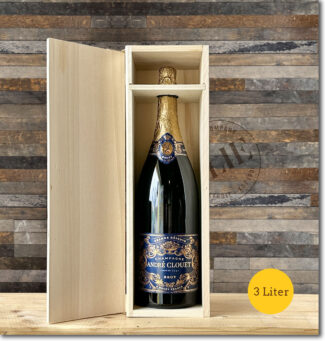 Champagne André Clouet ‘Grand Réserve’, Grand Cru Bouzy Brut ($370) 3 Liter
Champagne André Clouet ‘Grand Réserve’, Grand Cru Bouzy Brut ($370) 3 Liter
100% Pinot Noir from Bouzy. There’s nothing poetic about the term ‘3 liter’, but in Champagne parlance, this is a Jeroboam. It shows fresh, fine aromatics of apricot and yeast with a fruit-intense palate and a chalky-minerality and salty finesse on the finish with a nice jolt of lemony acidity.
*click photo for more info
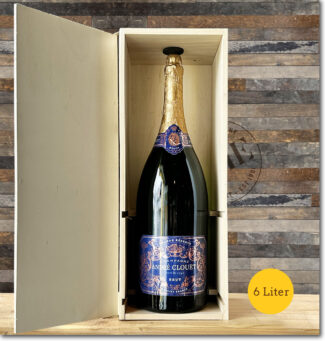 Champagne André Clouet ‘Grand Réserve’, Grand Cru Bouzy Brut ($650) 6 Liter
Champagne André Clouet ‘Grand Réserve’, Grand Cru Bouzy Brut ($650) 6 Liter
Who’s your daddy? 6 liter is a Methuselah—not the largest bottling format made in Champagne, but the biggest that mere mortals are likely to encounter.
*click photo for more info
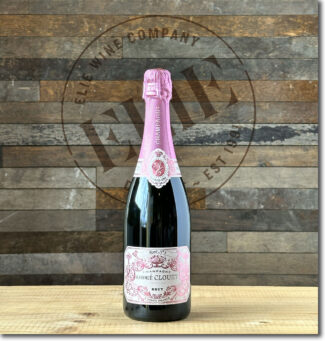 Champagne Andre Clouet ‘No 3’, Grand Cru Bouzy Rosé Brut ($58)
Champagne Andre Clouet ‘No 3’, Grand Cru Bouzy Rosé Brut ($58)
92% Pinot Noir, 8% vin rouge from Bouzy; the ‘3’ represents the style of the wine on an odd Clouet scale (inspired by Coco Chanel) where 1 is the lightest wine and 10, the richest. Driven by the chalky minerality of the terroir, the wine offers seductive notes of wild strawberry, raspberry, pomegranate, cherry blossoms, fresh red and pink flowers, crushed chalk, and orange zest.
*click photo for more info
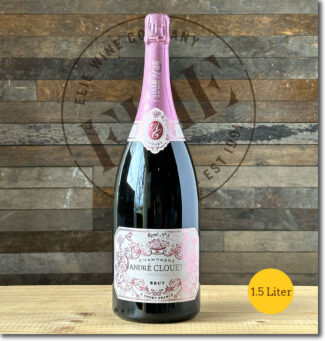 Champagne Andre Clouet ‘No 3’, Grand Cru Bouzy Rosé Brut ($110) 1.5 Liter
Champagne Andre Clouet ‘No 3’, Grand Cru Bouzy Rosé Brut ($110) 1.5 Liter
The magnum format of the above.
*click photo for more info
Champagne d’Auteur: Deeply Rooted, Daringly Innovative
It’s an interesting perspective: Terroir, not only as a sense of place, but as a sense of self. But of all the various elements that combine to make a wonderful bottle of wine—soil and sunshine, rain and rootstock—perhaps the most significant touch is the human one. Give two winemakers identical grapes, and they will make two different wines.
Says Jean-François Clouet, “A signature wine is one which expresses the philosophy or personality of a winemaker working in conditions of freedom and creativity. When surrounded by high quality fruit, and when dedicated to small volume production, the hand of the winemaker will be very present. Such a professional is free to play according to his own criteria, pampering the wine and trying methods that is, in many cases, outside the rules and production guidelines.”
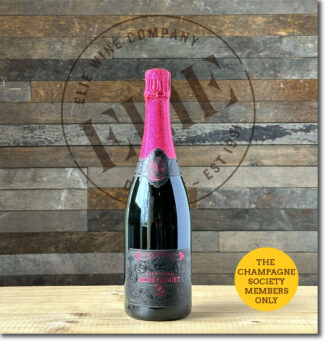 Champagne Andre Clouet ‘Spiritum 96’, Grand Cru Bouzy Rosé Brut ($81)
Champagne Andre Clouet ‘Spiritum 96’, Grand Cru Bouzy Rosé Brut ($81)
“Rosés are usually enjoyed while they are still young and fresh,” says Jean-François Clouet. “But I was looking for that complexity and fullness that exceptional wines acquire only after a very long maturation. I didn’t want to offer a rosé that had merely aged well; I wanted to combine the freshness and youth of a rosé wine with the essence of a great vintage. The key element in accomplishing this feat was going to be the liqueur!”
That goal led Clouet to use a concentration half that of a classic liqueur, giving the wine a final proportion of 88% Grand Cru Pinot Noir, 9% Rouge de Bouzy 2018 and around 3% Liqueur de Millésimé 1996.
*click photo for more info
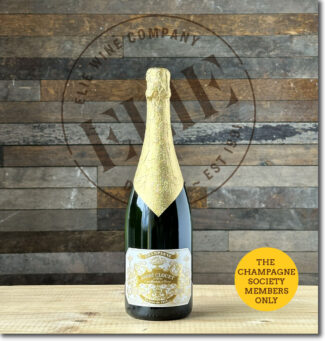 Champagne André Clouet ‘Cuvée 1911’, Grand Cru Bouzy Brut ($81)
Champagne André Clouet ‘Cuvée 1911’, Grand Cru Bouzy Brut ($81)
At dosage of 0.5 grams per liter, 50% of the wine was fermented in stainless steel tanks and 50% in Sauternes barrels. 50% perpetual reserve with an assemblage that also includes four vintages: all of which are made from Grand Cru Bouzy estate-grown fruit. The wine is delicately perfumed with sweet rose petal and jasmine and framed in austere minerality and balanced autolytic notes. Despite the relatively recent disgorgement, the mousse presents itself as extraordinarily elegant.
*click photo for more info
Le Clos: Jewel In The Crown, Single Vineyard
A walled garden is of itself a place of mystery and promise; add Jean-François Clouet’s secret ‘Bouzy Black Powder’, a substance he claims is found within the enclosed vineyard that hosts “our most beautiful genetic combinations of Pinot Noir” and you have a real storyline. The northwest-facing Clos contains chalky subsoil in thick layer, with soil amendments that are entirely organic, but the magical properties of the black powder were known only to the Druids, and after much experimentation, himself.
What can be said without needling the fact-checkers is this: There are only four Grand Cru Clos in all of Champagne, and Clouet’s ‘Le Clos’ is among the best.
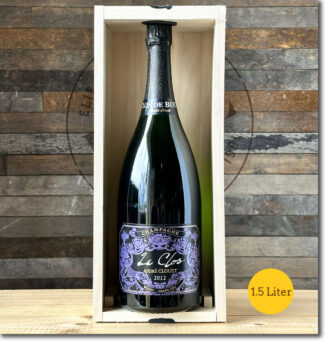 Champagne André Clouet ‘Le Clos’, 2012 Grand Cru Bouzy Brut ($320) 1.5 Liter
Champagne André Clouet ‘Le Clos’, 2012 Grand Cru Bouzy Brut ($320) 1.5 Liter
2012 is widely acknowledged as one of Champagne’s greatest vintages in decades, the result of a relatively warm winter moved into an extremely wet spring where both frost and a vicious hailstorm devastated yields. This cost growers, but benefitting drinkers as the reduced yields resulted in concentrated grapes that produced wines with great depth, complexity and aromatics along with balanced acidity.
This wine is only released in magnum format; the wine is aged in the Sauternes barriques of Château Doisy Daëne. The nose shows peach and almond evolving into a mineral finish quite reflective of the chalk terroir.
*click photo for more info
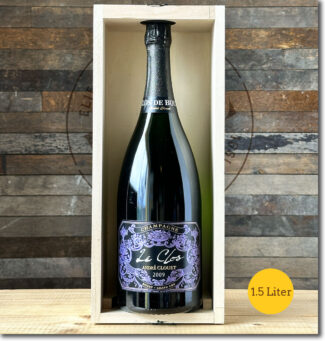 Champagne André Clouet ‘Le Clos’, 2009 Grand Cru Bouzy Brut ($380) 1.5 Liter
Champagne André Clouet ‘Le Clos’, 2009 Grand Cru Bouzy Brut ($380) 1.5 Liter
Vintage 2009: An exceptionally good vintage preceded by a dry winter that left the soils eagerly awaiting the spring rain, which came at an opportune time to ensure a successful budburst and flowering. After a stormy July, August delivered warm sunny days and cool, refreshing evenings as well as intense, dry heat that helped prevent rot and disease from taking hold. The resulting Champagnes tend to display rich, ripe orchard fruit reflecting the warm year and although acidity was far from searing, it was still very much present.
Bottled exclusively in magnums, the wine shows complex and dense scents of apple and cherry with a nice oxidative touch; chalk and discreet oak and mushroom aromas waft from the glass.
*click photo for more info
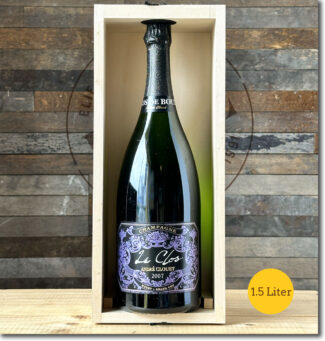 Champagne André Clouet ‘Le Clos’, 2007 Grand Cru Bouzy Brut ($320) 1.5 Liter
Champagne André Clouet ‘Le Clos’, 2007 Grand Cru Bouzy Brut ($320) 1.5 Liter
Vintage 2007: An unseasonably mild winter was followed by a sweltering April, prompting both early budburst and flowering. Then the rains began, signaling the beginning of an unusually cool and damp summer in which fighting rot and disease was an uphill battle. August finally brought warm weather and cleansing breezes which helped dry out the grapes, but harvest still came early, the result of the spring heatwave. Careful sorting was de rigeur, both in the field and in the cellar, and with due diligence the best producers were able to create wines of some merit.
‘Le Clos’, 2007 is one such wine. Post-harvest, the vin clair was fermented in stainless steel and selected barrels, with malolactic fermentations occurring there in these vessels respectively. En magnum.
*click photo for more info
The Magnum Effect
A magnum contains 1.5 liters of wine; a quantitative fact. Less understood is why Champagne producers consider this the ideal format for the vintage wines that connoisseurs intend to cellar for the long haul.
The reasons are several fold: First, since magnums hold twice as much as a standard 750 ml bottle but have the same ‘ullage’, or the space between the bottom of the cork and the wine’s surface, the wine’s exposure to oxygen is reduced in proportion. On a molecular level, this exchange of air and wine is key to the maturation process, generally leading to more complex flavors. The additional volume in a magnum also means that the wine is less sensitive to temperature fluctuations.
Autolysis is another chemical process in traditional sparkling wine production whereby yeast used for second fermentation in bottle breaks down and imparts flavor to the wine, especially the brioche/biscuit notes. In a magnum, the process is measurably slower since they have proportionally more glass surface than standard bottles, so there is more contact between lees on the inside of the bottle and the wine. This slows autolysis while greater contact with the yeast generates more roundness and greater complexity.
Millésimé Champagne: The Signature Of A Year
‘Millésimé’ refers to the process of harvesting, producing and bottling the grapes of a given year—a bit of information virtually always indicated on the label and the cork. Unlike terroir, which remains the same from year to year, Millésimé declarations are the result of exceptional weather in that site; a season in which the grapes achieve the perfect balance between two essential parameters, sugar and acidity.
It is a phenomenon that makes each Millésimé a special and rare Cuvée.
A vintage year is declared by the producer alone, and the well-known Comité Interprofessionnel du vin de Champagne cannot intervene. To reach this conclusion, the winemaker must recognize truly sublime characteristics in the vintage, meaning that the personality and aromatic intensity of the wines are such that they deserve special recognition. Additionally, since Millésimé Champagnes age for three to 10 years or more in the cellar before being marketed, it must be made from grapes with an ideal acid-sugar balance.
Interesting to note that Millésimé Champagnes may be declared in different years depending on the grape variety—an exceptional year for Chardonnay will not necessarily be so for Pinot Noir or Meunier, and vice versa.
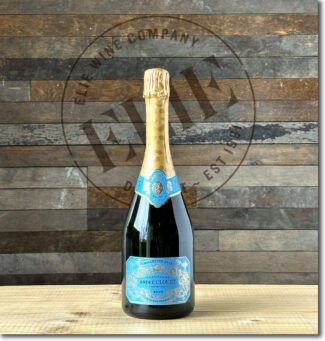 Champagne André Clouet ‘Léopard’, Millésimé 2015 Grand Cru Bouzy Brut ($63)
Champagne André Clouet ‘Léopard’, Millésimé 2015 Grand Cru Bouzy Brut ($63)
A leopard can’t change its spots, but a Chef de Cave can change his Assemblage. This blend is 80% Pinot Noir and 20% Chardonnay—the Champagne ages and then ferments in Sauternes barrels. The grapes are sourced from 100% Grand Cru vineyards in Bouzy, and from clay-calcareous parcels that face south and south-east to make the most of the sun and to ensure that the grape ripening is total and balanced. The Pinot Noir is intended to provide body and volume on the palate while the Chardonnay offers chalky length. At 5 grams per liter dosage, the wine promises a minimum of 20 years improvement in the bottle.
*click photo for more info
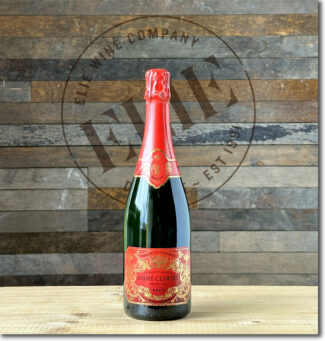 Champagne André Clouet ‘Dream’, Millésimé 2015 Grand Crus ‘Bouzy & Le Mesnil-sur-Oger’ Brut ($63)
Champagne André Clouet ‘Dream’, Millésimé 2015 Grand Crus ‘Bouzy & Le Mesnil-sur-Oger’ Brut ($63)
Founded in 1937, so remarkable is the terroir of Le Mesnil that 100% of its vineyards are ranked Grand Cru. It is situated at the heart of the prestigious Côte des Blancs, so-called (in part) because of the omnipresence of superb Chardonnay. East-facing slopes dominate the village, but vary from steeper inclinations close to the forest on top of the Côte des Blancs hill to almost flat land below the village.
The Chardonnay grapes are sourced as a grower swap for Pinot Noir, and the union of Le Mesnil-sur-Oger and Bouzy Chardonnay works to delightful effect. The tension and minerality of Le Mesnil is bolstered by the body and richness of Bouzy. Layered with spice, grapefruit and white peach.
*click photo for more info
The Vintage 2015: Champagne Is Heating Up
The 2015 vintage in Champagne has been referred to as ‘glittering.’ It was, for starters, the hottest vintage ever recorded in the region, and the extreme heat prevented the development of disease and rot; a few producers commented that these unusual circumstances meant their wines ended up adhering to organic standards purely through circumstance rather than intent. The intense heat ran from June through to August, with the end of August seeing a touch of relieving rain along with cooler nights. Along with being the hottest growing season on record, it was also one of the shortest: Harvest began late August and continued into early September.
Coteaux-Champenois Bouzy Grand Cru: Still Champagne
Covering the same territory as Champagne, Coteaux Champenois may be the wine world’s most celebrated oxymoron: Flat Champagne. By ‘flat’, of course, we are not talking about the week-old Chandon’s Brut in the back of the fridge or the after-effects of shaking a bottle of Cristal after winning the Grand Prix, but the intentional act of releasing a still wine from the same terroir that would otherwise undergo the extraordinary process used to create Champagne.
Spread across 319 communes, Coteaux Champenois producers are entitled to use seven varieties, alone or in tandem, including the Champagne staples Chardonnay, Pinot Noir and Meunier along with Arbane, Petit Meslier and the Pinot derivatives, Pinot Blanc and Pinot Gris. In general, all these grapes thrive at region’s latitude (48 – 49° North) although like their sparkling counterparts, Coteaux Champenois wines tend to be dry and light-bodied with naturally high acidity. The reds are much better in the warmer vintages of recent years, as the predominant variety, Pinot Noir, is able to ripen more consistently.
 Domaine André Clouet ‘Versailles Diamant’, 2015 Coteaux-Champenois Grand Cru Bouzy Blanc ($108)
Domaine André Clouet ‘Versailles Diamant’, 2015 Coteaux-Champenois Grand Cru Bouzy Blanc ($108)
Tyson Stelzer (Wine Spectator, Decanter, Vinous) refers to Diamant as ‘the best Coteaux Champenois I have tasted to date.’ Sourced from the Grand Cru vineyards of Bouzy and Ambonnay, the 100% Chardonnay wine spends 20 months in Vicard barrels. Beautifully textured, the wine shows green apple, lemon, tropical fruit, pineapple, dried flowers with a persistent lemon and lime finish.
*click photo for more info
 Domaine André Clouet ‘Versailles Rubis’, 2015 Coteaux-Champenois Grand Cru Bouzy Rouge ($108)
Domaine André Clouet ‘Versailles Rubis’, 2015 Coteaux-Champenois Grand Cru Bouzy Rouge ($108)
Produced from pure Pinot Noir sourced from Grand Cru vineyards in the heart of the Montagne de Reims, the varieties undisputed home. Like the Blanc, the Rouge is aged for 20 months in Vicard barrels—one of the finest coopers in the region. The wine shows tart cherry behind silky tannins a clear and pronounced minerality on the palate.
*click photo for more info
Notebook …
Drawing The Boundaries of The Champagne Region
To be Champagne is to be an aristocrat. Your origins may be humble and your feet may be in the dirt; your hands are scarred from pruning and your back aches from moving barrels. But your head is always in the stars.
As such, the struggle to preserve its identity has been at the heart of Champagne’s self-confidence. Although the Champagne controlled designation of origin (AOC) wasn’t recognized until 1936, defense of the designation by its producers goes back much further. Since the first bubble burst in the first glass of sparkling wine in Hautvillers Abbey, producers in Champagne have maintained that their terroirs are unique to the region and any other wine that bears the name is a pretender to their effervescent throne.
Having been defined and delimited by laws passed in 1927, the geography of Champagne is easily explained in a paragraph, but it takes a lifetime to understand it.
Ninety-three miles east of Paris, Champagne’s production zone spreads across 319 villages and encompasses roughly 85,000 acres. 17 of those villages have a legal entitlement to Grand Cru ranking, while 42 may label their bottles ‘Premier Cru.’ Four main growing areas (Montagne de Reims, Vallée de la Marne, the Côte des Blancs and the Côte des Bar) encompass nearly 280,000 individual plots of vines, each measuring a little over one thousand square feet.
The lauded wine writer Peter Liem expands the number of sub-regions from four to seven, dividing the Vallée de la Marne into the Grand Vallée and the Vallée de la Marne; adding the Coteaux Sud d’Épernay and combining the disparate zones between the heart of Champagne and Côte de Bar into a single sub-zone.
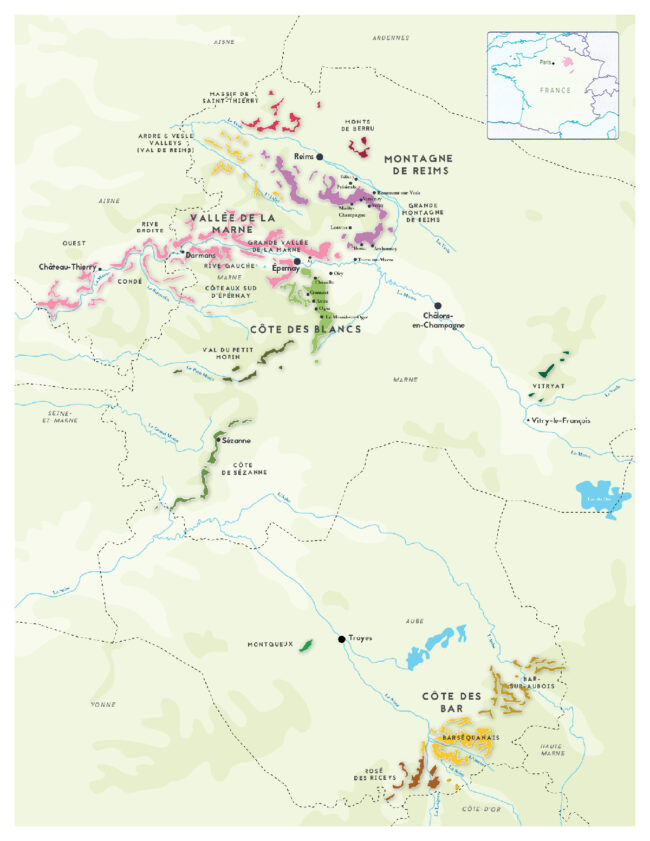
Courtesy of Wine Scholar Guild
Lying beyond even Liem’s overview is a permutation of particulars; there are nearly as many micro-terroirs in Champagne as there are vineyard plots. Climate, subsoil and elevation are immutable; the talent, philosophies and techniques of the growers and producers are not. Ideally, every plot is worked according to its individual profile to establish a stamp of origin, creating unique wines that compliment or contrast when final cuvées are created.
Champagne is predominantly made up of relatively flat countryside where cereal grain is the agricultural mainstay. Gently undulating hills are higher and more pronounced in the north, near the Ardennes, and in the south, an area known as the Plateau de Langres, and the most renowned vineyards lie on the chalky hills to the southwest of Reims and around the town of Épernay. Moderately steep terrain creates ideal vineyard sites by combining the superb drainage characteristic of chalky soils with excellent sun exposure, especially on south and east facing slopes.
… Yet another reason why this tiny slice of northern France, a mere 132 square miles, remains both elite and precious.
- - -
Posted on 2024.03.01 in France, The Champagne Society, Champagne
Featured Wines
- Notebook: A’Boudt Town
- Saturday Sips Wines
- Saturday Sips Review Club
- The Champagne Society
- Wine-Aid Packages
Wine Regions
Grape Varieties
Aglianico, Albarino, Albarín Blanco, Albarín Tinto, Albillo, Aleatico, Arbanne, Aubun, Barbarossa, barbera, Beaune, Biancu Gentile, bourboulenc, Cabernet Franc, Cabernet Sauvignon, Caino, Caladoc, Calvi, Carcajolu-Neru, Carignan, Chablis, Chardonnay, Chasselas, Clairette, Corvina, Cot, Counoise, Erbamat, Ferrol, Fiano, Frappato, Friulano, Fromenteau, Fumin, Garnacha, Gewurztraminer, Godello, Graciano, Grenache, Grolleau, Groppello, Juan Garcia, Lambrusco, Loureira, Macabeo, Macabou, Malvasia, Malvasia Nera, Marsanne, Marselan, Marzemino, Melon de Bourgogne, Merlot, Mondeuse, Montanaccia, Montepulciano, Morescola, Morescono, Moscatell, Muscadelle, Muscat, Natural, Nero d'Avola, Parellada, Patrimonio, Petit Meslier, Petit Verdot, Pineau d'Aunis, Pinot Auxerrois, Pinot Blanc, Pinot Gris, Pinot Meunier, Pinot Noir, Poulsard, Prieto Picudo, Rondinella, Rousanne, Roussanne, Sangiovese, Sauvignon Blanc, Savignin, Semillon, Souson, Sparkling, Sumoll, Sylvaner, Syrah, Tannat, Tempranillo, Trebbiano, Trebbiano Valtenesi, Treixadura, Trousseau, Ugni Blanc, vaccarèse, Verdicchio, Vermentino, Viognier, Viura, Xarel-loWines & Events by Date
- April 2024
- March 2024
- February 2024
- January 2024
- December 2023
- November 2023
- October 2023
- September 2023
- August 2023
- July 2023
- June 2023
- May 2023
- April 2023
- March 2023
- February 2023
- January 2023
- December 2022
- November 2022
- October 2022
- September 2022
- August 2022
- July 2022
- June 2022
- May 2022
- April 2022
- March 2022
- February 2022
- January 2022
- December 2021
- November 2021
- October 2021
- September 2021
- August 2021
- July 2021
- June 2021
- May 2021
- April 2021
- March 2021
- February 2021
- January 2021
- December 2020
- November 2020
- October 2020
- September 2020
- August 2020
- July 2020
- June 2020
- May 2020
- April 2020
- March 2020
- February 2020
- January 2020
- December 2019
- November 2019
- October 2019
- September 2019
- August 2019
- July 2019
- June 2019
- May 2019
- April 2019
- March 2019
- February 2019
- January 2019
- December 2018
- November 2018
- October 2018
- September 2018
- August 2018
- July 2018
- June 2018
- May 2018
- April 2018
- March 2018
- February 2018
- January 2018
- December 2017
- November 2017
- October 2017
- September 2017
- August 2017
- July 2017
- June 2017
- May 2017
- April 2017
- March 2017
- February 2017
- January 2017
- December 2016
- November 2016
- October 2016
- September 2016
- August 2016
- July 2016
- June 2016
- May 2016
- April 2016
- March 2016
- February 2016
- January 2016
- December 2015
- November 2015
- October 2015
- September 2015
- August 2015
- July 2015
- June 2015
- May 2015
- April 2015
- March 2015
- February 2015
- January 2015
- December 2014
- November 2014
- October 2014
- September 2014
- August 2014
- July 2014
- June 2014
- April 2014
- March 2014
- February 2014
- January 2014
- December 2013
- November 2013
- October 2013
- September 2013
- August 2013
- July 2013
- June 2013
- May 2013
- April 2013
- March 2013
- February 2013
- January 2013
- December 2012
- November 2012
- October 2012
- February 2004
Search


